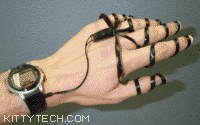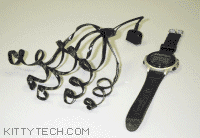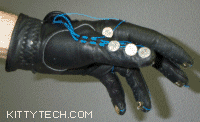 |
Handy Touch-TypingWith
recent advances in portable computing and in particular
the design of pocket PCs (e.g. http://wearables.stanford.edu/main.html
) and eye-glass displays (e.g. http://www.microopticalcorp.com/ , http://www.machinebrain.com/ ),
increasing effort has been spend in the design of
portable input devices (and methods).
Microphones
using voice recognition software have been used and
developed not only since the advent of portable
computing. However, for the latter purpose, privacy
concerns for its use in settings such as airplanes or
conference meetings are obvious. This is particularly
true for the input of sensitive information.
Miniaturization of traditional keyboards using for
example key reduction and the design of one-hand devices
(chording devices) based on their own coding structure
have recently hit the market, e.g. the "twiddler" (http://www.handykey.com/) or are on
the drawing board (e.g. http://wearables.blu.org/hardwear.html,
). The latter also includes existing glove based systems
(e.g. the "Chording-Glove" by Robert Rosenberg at
University College of London, the "KeyGlove" by R. Paul
McCarty at Rochester University or the glove-based
system by Vaughan R. Pratt at Stanford University using
the "Thumbcode" procedure (http://boole.stanford.edu/thumbcode/cat),
where electrical contacts are placed on a single glove
worn by its user, producing specific character input by
closing pairs or multiple of these contacts according to
a specified coding layout. A researcher from the
University of California at Irvine UCI has recently
proposed a data-input method for a similar
finger-mounted device (using for example two "gloves")
which mimics the finger movement known from traditional
touch-typing in order to provide alphabetical and
numerical data input. |
|
The new device (i.e. system and method)
guarantees a virtually zero learning curve for those
well versed in touch-typing.
Production
costs will be low since discrete signals are generated
by the opening and closure of electric circuits totally
analogous to existing keyboard technology. In addition,
the ultra-portable device does not have the drawbacks of
other systems [e.g. the "Virtual Keyboard" by Senseboard
(http://www.senseboard.com/ ), the
"Lightglove" (http://www.lightglove.com/ ) or the
"Scurry" by Samsung (http://www.samsung.com/ )], which also
use touch-typing for alphabetic character input but
which are based on continuous signal processing (which
is error prone and involves the use of fairly expensive
sensors) and which require the user to preserve a
certain reference position with their hands in the
course of touch-typing. Naturally, the new system can
also be reduced for one-handed data-input using for
example wrist-position detection to toggle between two
character-set analogous to the method known from systems
such as the halfkeyboard (http://www.halfkeyboard.com/
).
As expressed by Dr. Mehring from UC
Irvine, the new device tries to give glove-based or
finger-mounted systems a new shot at the portable input
device market by taking advantage of the existing skills
of its potential users. As of today, user acceptance for
newly developed ultra-portable input devices which can
provide high rates of data-input required for ever more
powerful pocket computers is limited by the requirement
imposed on the user to learn new ways of data
input.
"Proof of concept" for the method proposed
by Dr. Mehring has been demonstrated with a first
glove-based proto-type (see photograph). Less intrusive
design concepts have already been developed and are
currently pursued. One of these designs uses
printed-circuit electrical wires on thin flexible
spiral-shaped substrate strips winding around each
finger of the hand and providing electrical contacts on
thumbs and fingertips and/or alongside each finger to
generate all the characters found on a traditional
keyboard using traditional touch-typing skills (see
photographs). Plans for commercialization and licensing
are underway.
|

Non-intrusive
Comfortable
Lightweight

Advanced KITTY
design

Spiral-shaped
printed-circuit wires
connecting to
"watch-like" unit
carrying
wireless
transmission
electronics

Glove-based
prototype
(one hand shown only)
|